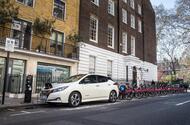Opinion
Kia’s President Brings Toyota-like Confidence: Editor’s Letter
 Ho Sung Song has led a dramatic brand reinvention since he took the reins in 2020
Ho Sung Song has led a dramatic brand reinvention since he took the reins in 2020
Despite being vast industrial global companies, car makers can still have the impact of an individual felt.
Toyota is a great example, the premiership of the effervescent Akio Toyoda throughout the 2010s adding a previously unimaginable human side to this most corporate of car firms.
The main figure at the heart of Kia’s rise this century was designer Peter Schreyer, who was positioned as de facto leader of the company and successfully moved the Korean firm from a dowdy budget brand to a more aspirational mainstream one.
Kia now has another charismatic individual moving it forward again: Ho Sung Song, Kia's president and CEO.
He took the top job in 2020 after 13 years at the company and has overseen a new brand image that’s shaken Kia’s budget feel for good. Song has used the introduction of EVs to go even bolder; the likes of the EV6 and EV9 can see off far more costly and staid rivals, while the EV3 feels good enough to become a Volkswagen Golf-style default choice in the electric era.
Kia is making BMWs for the people (its latest design boss Karim Habib is formerly of Munich…) while still very happy to fill the void left by Ford in making cars at volume. More impressively, Kia’s ceiling for making larger and more expensive cars that people are willing to buy and can be sold profitably feels much higher than Ford’s.
It’s easy to see why Kia has so much confidence when you spend time in Song’s company. Friendly and hospitable, Song will answer questions honestly and directly and knows how the world works outside Korea; his stints in several major global markets including the UK for his previous employer Hyundai helped shape that.
Tariffs on Chinese-made electric cars imported into the EU are “fair game” to counter state support, while the UK’s controversial mandate on the sale of electric cars is a good thing in Song’s eyes as it ultimately forces the market. He sees city cars as an essential part of a manufacturer’s offering to ensure cars are accessible and affordable in the electric era, so is desperate to launch a sub-€20,000 model by 2030.
He’ll just as happily talk golf; like many Koreans, Song is a golf nut and plays to a single-digit handicap even as a CEO working 12-hour days.
‘Why not?’ often comes back as the response when further challenges or markets to enter are put to Song, but for now the next horizon is vans.
In January, Kia revealed plans for a new family of electric vans that will start to see production late next year, sold in dedicated van dealerships.
It's a good time and a good way to get into the van market, as while electric propulsion is the mandated future, it will stay a minority choice for longer than cars, due to cost and range issues in a sector where time on the road and total cost of ownership are everything.
While Europe is the focus for vans, they can have an impact elsewhere. When Song looks outside the window of his EV9 (he uses the massaging seats as an antidote to Seoul’s terrible traffic) he wouldn’t see a van at all, rather small trucks with different beds on the back and a cab on the front.
The likes of the Hyundai Porter and Kia Bongo are among Korea’s best-selling vehicles, yet crash safety regulations will kill them off from 2027, and Kia senses an opportunity here for the likes of the PV5, too. Something will need to replace them, and why not the PV5?
Kia can start small, learn and build as the electric van market grows, although taking on Ford here is perhaps Kia’s biggest task yet. Though as one company official told me, Kia’s goal is never to match the best, but to beat it.
The Cost Range of Classic Land Rover Defenders: £7k to £230k | Giga Gears
 Can a fancy restomod really be 33 times better than the classic 4x4?
Can a fancy restomod really be 33 times better than the classic 4x4?
What a month for Land Rover Defender residuals, with the announcement of not one but two restoration-and-modification specials.
I also see that we’re deep into territory that I predicted (go me) in 2016, when I thought that within a few years, old Defenders would be rebranded as Defender Classics.
I was partly right: it seems to be Classic Defender, going by the official title bestowed by Land Rover Classic on its most recent few editions.
The latest is the Land Rover Classic Defender V8 by Works Bespoke, perhaps announced now as a reminder to anyone contemplating a Grenadier Detour from Ineos’s new Arcane Works division that the original maker of cars that look like this is still doing a trade in them. Ineos is a company of which JLR, I think it’s fair to say, is no great fan.
The Works etc isn’t the first Defender to get a serious overhaul from Land Rover Classic, with the company basically doing enough to uprate the car without (according to DVLA rules, which should be followed by all restomodders) doing so much that the car ends up with a Q numberplate.
There’s a serious interior makeover on top and, I have to say, an external paint and wheel refresh that makes the 110 that they’ve used for the promotional pictures, on steelies and with a white roof, border on my perfect classic Defender spec.
Also step forward Oxfordshire firm Kingsley Cars. It has done a long line of classic Range Rover restorations and mods and now, apparently under new ownership, it has added Defenders to it too.
It’s not a dissimilar deal to the official Land Rover offering (or to that of other restomodders) in that you can have a V8 should you want to. Kingsley can be more liberal than JLR about the ones it selects, so you could choose a General Motors LS. And there’s quite a nifty configurator, for those of us who are prone to spending time on such things, as I am.
But the thing about both of these and others (I’m also fond of the work done by Twisted) is the cost: from around £168,000 for a car from Kingsley and from £228,000 for something from Land Rover Classic. And the more bespoke you go, the more expensive it gets.
While I totally get that level of pricing for what you might define as exotic classics, it feels weird for a car that started in life – and in many cases still exists in life – as a working vehicle.
The cheapest Defender 90 for sale on Auto Trader as I write is a 1990 2.5-litre turbo diesel pick-up on steel wheels at just under £7000. It appears to be very scruffy around the edges but has a full history and a new MOT and it looks so brilliant that, despite already owning a Defender, I’d quite like it.
There’s only so good you can make an old Defender within the rules of it staying, y’know, a Defender. And I’m not sure that one can really be 33 times better than another.
But the world of Defenders is odd like that. When I briefly toyed with selling mine, a mate considered buying it, and thankfully opted against it. Instead, he picked up an ex-farm car for approximately £10,000 (I forget exactly), spent a few thousand on accessories like an exterior roll cage and a winch and some cool wheels and sold it for almost £30,000.
I’m not sure there’s another vehicle that has such a wild disparity of pricing. Should I ever want or need to sell mine, I think I’ll hit the accessories catalogues first.
Can China Rescue the UK Car Industry? | Giga Gears

Chery-owned Omoda is among the Chinese brands making waves in the UKChinese officials are aware of the opportunity in the UK, comparing it to Japanese investment in the 1980s
The UK's continuation of regulatory alignment with the EU on automotive matters post-Brexit would seem to suggest that the imposition of extra import tariffs on Chinese-made EVs is inevitable, the European bloc having taken that step to protect its industry from cheap imports from China.
However, unlike the EU, the UK no longer has much of a mainstream domestic manufacturing industry to protect, so the ‘threat’ isn’t really one at all.
Retaliatory tariffs from Beijing are set to target large premium cars from the likes of BMW and Mercedes-Benz in one of the few market segments that Chinese brands have yet to get to grips with at home.
Should Westminster follow Brussels in taxing Chinese EVs (new business secretary Jonathan Reynolds has said it has no plans to do so), it should expect the same retaliatory tariffs as a result – which would be bad news for the likes of Bentley, JLR and Rolls-Royce.
The EU’s tariffs can be circumvented by Chinese car makers by opening factories in Europe – which is where an opportunity presents itself to the UK. By not imposing tariffs, the UK’s exports will be protected from retaliatory measures and it will be seen as a far friendlier country with which to do business, opening the possibility of Chinese car makers locating their European factories on these shores, creating new jobs.
This would also ensure that a more affordable supply of EVs could be offered in the UK as part of the government’s own directive that 80% of car sales must be electric by 2030 – much needed, as the market is already lagging well behind on the 22% mandated this year.
More broadly, UK car production needs fresh investment if it ’s to ever grow again. Recent successes have nearly all been about preserving what factories remain, rather than attracting new ones. The Chinese opportunity is the UK’s only realistic chance of growth at volume.
Chinese officials are known to be well aware of this opportunity. They recall how in the 1980s the UK government worked closely with Nissan to secure the Japanese giant’s successful and stillgrowing presence here.
Such a scenario would require a symbolic thawing of attitude to China from the UK, taking us back to David Cameron’s ‘golden era’ of relations, after subsequent governments banned China from being involved in major infrastructure due to security concerns.
On the automotive front, those concerns are about ‘spying’ from Chinese cars – a broad term that if proven would be commercial suicide for any car maker. A Norwegian consortium of cybersecurity experts has been trying to understand this ‘spying’ claim by totally tearing down a Nio EV - so far without cause for alarm.
Maserati’s Silent Revival: A Potential Triumph | Giga Gears

"Naughty streak" can make a Maserati more fun than a PorscheWith a comprehensive line-up and a clear, cohesive identity, Maserati stands out under the Stellantis umbrella
Over the past couple of years, Maserati’s rush of model renewal has created plenty of work for us road testers, but it has also led to a fresh sense of familiarity with its cars that’s broadly encouraging.
The company is undergoing one of those revival moments, having received some investment to develop new cars that might actually stick it to the Germans. Will a bunch of 3.5-star cars be enough to do that? Well, let’s just zoom out for a moment.
As model range renewals go, Maserati’s is pretty extensive. While Jaguar has withdrawn all but one of its cars from sale until new EVs arrive, the Modenese firm has made all but one of its cars less than three years old.
Some have suggested that the trident pig is just being fattened up for market (though a spokesperson recently denied that Stellantis has plans to sell Maserati). But I’d say getting rid of it would be a huge loss.
The firm has done a surprisingly thorough job in covering market territory. The Grecale SUV, Granturismo and Grancabrio are all available with petrol and electric power, and an electric MC20 is supposedly coming to complement the existing petrol version.
Continuing to give customers choice like this seems a canny move, because while there’s no getting away from the governmental drive for EV adoption, actual consumer appetite still lags behind.
There’s a chance that Porsche might look a little silly with its electric-only Macan come 2025 – but you’ll still be able to buy a petrol Grecale, even if increasing taxes and restrictions might make the latter prohibitively expensive.
Then again, maybe undertaking to build a convincing electric and piston version of each model has stretched development resources too thin. As we recently learned, the electric Grecale Folgore feels several years behind the competition as a luxury EV and it isn’t nearly as good to drive as its petrol siblings.
Which, if I was running the company, would be a definite worry, but at least the wider picture is more convincing.
Maserati’s petrol-powered cars may not be as objectively ‘good’ as rivals and they’re typically about 15% more expensive than feels justified – but they share a distinctive character that makes them very likeable indeed.
Just as every Porsche – whether it’s a base Cayenne or a 911 S/T – feels unmistakably like a Porsche, Maseratis (except for that electric Grecale) have quite an innately Maserati feel.
Their controls are quite light but do have feedback, and respond in a measured way, making the cars very intuitive to drive. There’s also a clear focus on comfort that sets Maseratis apart from rivals that are trying too hard to be sporty.
And yet there’s enough of a naughty streak that often actually makes them more fun.
So the cars are mostly good and distinctive, there’s cohesion within the range and the Maserati brand retains its special status; it’s the only one in the Stellantis stable that might ever comfortably occupy that lucrative sub-Bentley space. And unlike a certain British car maker aiming for the same tranche, Maserati actually has a range of cars to sell you today.
There have been bumps in the road, then – but of the many brands fighting for a place under the Stellantis umbrella, Maserati might be the one with the clearest identity, and the best chances of long-term success, if it can just be that bit more consistent.
ZEV Mandate: More Losers than Winners | Giga Gears
 Government should focus on stimulating demand for EV rather than penalising car makers for a lack thereof
Government should focus on stimulating demand for EV rather than penalising car makers for a lack thereof
Is this the week the mask slipped off the UK’s zero emission vehicle (ZEV) mandate?
Explosive comments from the CEO of Vertu Motors, one Britain’s biggest car dealer groups, referenced the ZEV mandate as having created a “state-imposed supply chain”.
Robert Forrester said that car makers were holding back the supply of ICE cars until 2025 while trying to push buyers into electric cars.
The latest What Car? Target Price data has revealed that the average discount on a new EV is almost 10%, with the biggest discounters being Mazda (25% on average), Jeep (21%) and Audi (15%).
Yet even with hefty discounts, private buyers are shunning EVs,
"It’s almost as if we can’t supply the cars that people want but we’ve got plenty of the cars that maybe they don’t want,” said Forrester.
Car makers are increasingly peeved about the ZEV mandate and are being increasingly vocal about it, questioning the gap between public demand and legislated targets for EVs.
If the demand isn’t there, it’s the car makers who are on the hook, facing fines for any shortfall in sales.
Stellantis CEO Carlos Tavares, whose brands continue to launch EVs apace and at increasingly lower costs, has placed his UK factories under review as “we cannot be making these [vans] in the UK and being the victims of the ZEV mandate; this is a contradiction that the company cannot accept”.
It’s a struggle to see who is winning in all this. As Forrester pointed out, it's bad for business, because discounting erodes profitability to the point where car makers are losing money on EVs. And by constraining the new car market, the government is losing out on VAT receipts and putting manufacturing facilities like Stellantis’s at risk.
EV sales rose in August, but August is always an unusual month for car sales ahead of the September numberplate change, and the Society of Motor Manufacturers and Traders has now downgraded its forecast for EV sales in 2024 to below the crucial 22% mark.
This will only get worse next year, when the 22% target leaps to 28%. There’s nothing to suggest, nor is there a way to see, how things will get any better before then.
As it stands, the legislation can't be reviewed until the end of 2026, at which point fines would need to be paid by any non-compliant car maker, as missed targets in one year can be carried over to the next for up to three years, albeit with interest.
This all creates a pessimistic tone in the discussion about EVs.
When the market gets talked down, so the cars get talked down with them, yet the reality is that EVs are getting ever better and ever cheaper and will work for a lot more people than the demand suggests.
The government should focus on stimulating that demand rather than penalising car makers for it not being there.
